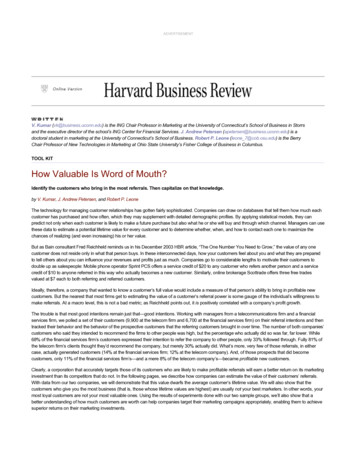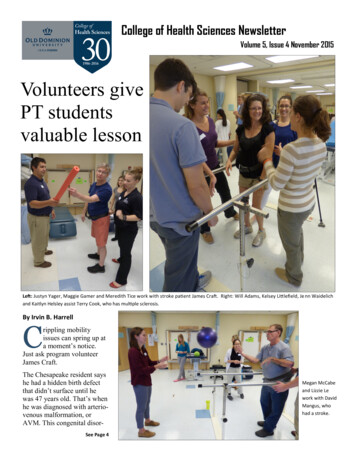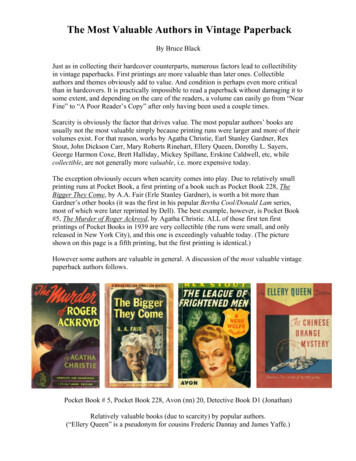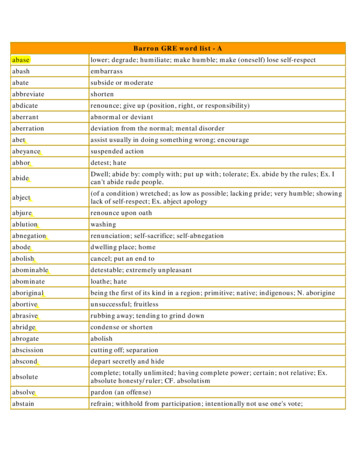
Transcription
ADVERTISEMENTV. Kumar (vk@business.uconn.edu) is the ING Chair Professor in Marketing at the University of Connecticut’s School of Business in Storrsand the executive director of the school’s ING Center for Financial Services. J. Andrew Petersen (apetersen@business.uconn.edu) is adoctoral student in marketing at the University of Connecticut’s School of Business. Robert P. Leone (leone 7@cob.osu.edu) is the BerryChair Professor of New Technologies in Marketing at Ohio State University’s Fisher College of Business in Columbus.TOOL KITHow Valuable Is Word of Mouth?Identify the customers who bring in the most referrals. Then capitalize on that knowledge.by V. Kumar, J. Andrew Petersen, and Robert P. LeoneThe technology for managing customer relationships has gotten fairly sophisticated. Companies can draw on databases that tell them how much eachcustomer has purchased and how often, which they may supplement with detailed demographic profiles. By applying statistical models, they canpredict not only when each customer is likely to make a future purchase but also what he or she will buy and through which channel. Managers can usethese data to estimate a potential lifetime value for every customer and to determine whether, when, and how to contact each one to maximize thechances of realizing (and even increasing) his or her value.But as Bain consultant Fred Reichheld reminds us in his December 2003 HBR article, “The One Number You Need to Grow,” the value of any onecustomer does not reside only in what that person buys. In these interconnected days, how your customers feel about you and what they are preparedto tell others about you can influence your revenues and profits just as much. Companies go to considerable lengths to motivate their customers todouble up as salespeople: Mobile phone operator Sprint PCS offers a service credit of 20 to any customer who refers another person and a servicecredit of 10 to anyone referred in this way who actually becomes a new customer. Similarly, online brokerage Scottrade offers three free tradesvalued at 7 each to both referring and referred customers.Ideally, therefore, a company that wanted to know a customer’s full value would include a measure of that person’s ability to bring in profitable newcustomers. But the nearest that most firms get to estimating the value of a customer’s referral power is some gauge of the individual’s willingness tomake referrals. At a macro level, this is not a bad metric; as Reichheld points out, it is positively correlated with a company’s profit growth.The trouble is that most good intentions remain just that—good intentions. Working with managers from a telecommunications firm and a financialservices firm, we polled a set of their customers (9,900 at the telecom firm and 6,700 at the financial services firm) on their referral intentions and thentracked their behavior and the behavior of the prospective customers that the referring customers brought in over time. The number of both companies’customers who said they intended to recommend the firms to other people was high, but the percentage who actually did so was far, far lower. While68% of the financial services firm’s customers expressed their intention to refer the company to other people, only 33% followed through. Fully 81% ofthe telecom firm’s clients thought they’d recommend the company, but merely 30% actually did. What’s more, very few of those referrals, in eithercase, actually generated customers (14% at the financial services firm; 12% at the telecom company). And, of those prospects that did becomecustomers, only 11% of the financial services firm’s—and a mere 8% of the telecom company’s—became profitable new customers.Clearly, a corporation that accurately targets those of its customers who are likely to make profitable referrals will earn a better return on its marketinginvestment than its competitors that do not. In the following pages, we describe how companies can estimate the value of their customers’ referrals.With data from our two companies, we will demonstrate that this value dwarfs the average customer’s lifetime value. We will also show that thecustomers who give you the most business (that is, those whose lifetime values are highest) are usually not your best marketers. In other words, yourmost loyal customers are not your most valuable ones. Using the results of experiments done with our two sample groups, we’ll also show that abetter understanding of how much customers are worth can help companies target their marketing campaigns appropriately, enabling them to achievesuperior returns on their marketing investments.
Measuring a Customer’s ValueEstimating a customer’s lifetime value (CLV) is relatively straightforward. Let’s imagine that Mary is a customer of FirmCo. The value to FirmCo ofall that Mary will ever buy equals the amount that her purchases will contribute to FirmCo’s operating margin minus the costs of marketing to her. Noone really knows how much Mary will buy from FirmCo in the future, but we can make an estimate by analyzing her past purchases over some periodof time, working out the purchasing pattern, and then projecting that pattern forward over some future period of time using sophisticated statisticalmodels. From this we subtract the marketing costs, both those involved in acquiring Mary and those we budget to retain her during that future period.Her CLV is the net present value of that sum.That’s what we did with our two samples. We analyzed each customer’s transactions on a monthly basis and projected forward for a year thediscounted average monthly contribution less marketing costs to obtain our CLV estimates. A year’s projected business gives a number that isnormally about half of a customer’s full lifetime value, although that can vary by industry. Our purpose in calculating a one-year CLV is to maintain aconsistency in time period with our estimates of referral value.Calculating Mary’s referral value (CRV) is more complicated than calculating her lifetime value. We must first estimate the average number ofsuccessful referrals she will make after we offer her an incentive to do so through a marketing campaign. As we do for her CLV, we look at Mary’spast behavior, but we need to look at a period longer than a month to get enough variance in the number of referrals for proper statistical modeling andpredictive accuracy. The appropriate time frame for analysis is different for different industries. We found that the optimum observation period wasthree months for the telecom company and six months for the financial services company.In addition, we need to estimate how much time can go by and still be sure that Mary’s referrals are actually prompted by our referral incentive. In ourexperience, referrals made by customers after a referral-incentive marketing campaign can be attributed to that campaign for about a year. So wecount only those referrals made within a year, erring in our prediction of referral behavior, as we did with our CLV calculation, on the side of caution.Next, we must estimate how many of those referrals would have become FirmCo customers anyway, even if Mary had not recommended thecompany. The distinction is important. If a new customer, let’s call him John, would not have joined without Mary’s referral (what we call a “type-one”referral), then Mary’s referral value should incorporate the value of John’s business. But if John would have become a customer without Mary’sreferral (a “type-two” referral), then Mary’s CRV should incorporate only the savings in acquisition costs for John, since no direct marketing effort wasneeded to get him. To estimate how many of Mary’s referrals are type-two customers, we would ideally survey all the people she referred and askthem directly whether or not they would have bought FirmCo’s product or service without the referral.From similar surveys we conducted of the customers referred by our sample groups, we estimated that, on average, each customer made an equalproportion of type-one and type-two referrals. As online business increases and online surveying becomes more effective, companies will be able todetermine these proportions not just on an average basis, but for each customer.Mary’s referral value, then, is the present value of her type-one referrals plus the present value of her type-two referrals. Let’s suppose John would nothave become a customer had Mary not referred him to FirmCo. The value of Mary’s type-one referral of John is essentially the same as his lifetimecustomer value: the present value of the difference between John’s contribution to margin and the cost of marketing to him, projected over one year.The important thing here, though, is that John’s lifetime value is not necessarily higher or lower than Mary’s, despite the lower cost of acquisitionmarketing to him. (Even though FirmCo acquired Mary through costly and inefficient direct marketing, and acquired John merely by giving Mary anincentive to make the referral, John might turn out to purchase more or less than Mary does.) Marketing costs involved in retaining John after hisacquisition remain, of course, the same as those involved in retaining Mary.The value of type-two customers, as we’ve noted, is simply the present value of the savings in acquisition costs. Note that if the cost involved inacquiring type-two referrals exceeds the cost of alternative acquisition methods, type-two customers can be a liability. For the two formulae, see theexhibit “Estimating Customers’ Lifetime and Referral Values.”
What the Calculation RevealsTo see how much the CRV calculation can affect total customer values, we will apply our valuation formulas to a customer from each sample. Afterobtaining estimates for purchases, purchase frequency, and retention-marketing costs from historical data for the two, we estimated a CLV of 144 forthe financial services customer and 245 for the telecom customer. While significant, these numbers are far lower than these customers’ referralvalues. Analysis of prior referral behavior suggests that after the launch of a referral program, these customers will typically refer four customers ineach observation period, of which half are type-one referrals and half are type-two. Calculating the value of these referrals going forward for one yearfor each customer gives us a CRV for the financial services customer of 257 and a CRV for the telecom customer of 1,049, in both casessignificantly greater than their CLVs.In reality, those numbers underestimate true referral value. Referred customers make their own referrals in turn, and credit for these should also betraced back to the original referring customer. In our hypothetical example, when we surveyed John to see if he would have become a FirmCocustomer without Mary’s referral, we also asked him if he had recommended the company to anyone himself. Say he passed on the good word to twomore people. Mary should get credit for those referrals as well.Now let’s assume that John is representative of all of Mary’s type-one referrals. That means that in each period Mary acquires two customers for thecompany, who go on in the subsequent period to acquire two more customers each (or four in total) at the same time that Mary is continuing to acquiretwo additional customers herself. Over two typical periods, therefore, Mary is responsible for bringing on board eight new customers (the four sheacquires directly and the four she’s responsible for indirectly). Mary’s cumulative total rises geometrically in each period until the year is over, as eachnew customer continues to bring in two more customers.When we assumed that the ratio of type-one to type-two customers remained constant, we found that over four observation periods the total CRV of thefinancial services customer ballooned to 4,632 (we got 6,305 for the telecom customer). For the purposes of this article, however, we have elected tobe cautious in our CRV measurement, and in the pages that follow we do not take indirect referrals into account.If customer lifetime value and customer referral value were simply and positively correlated, the difference between them would not be particularlyinteresting from a managerial perspective. Any action that would increase lifetime value would immediately translate into higher referral value. Butwhen we looked into the specific referral behavior of customers with different CLV levels, we found that a high CLV is not a good predictor of CRV and
so is a very questionable proxy for a customer’s total value. As the exhibit “The Doing-Saying Gap” shows, there was no overlap at all in the telecomcompany sample between customers with high referral values and those with high lifetime values. Any customer segmentation scheme for thiscompany, therefore, would have to explicitly take both the purchase and the referral dimensions into account.The obvious way to do this is to break the sample down into the four cells of a two-by-two matrix, which we’ve done for our telecom company samplein the exhibit “The Customer Value Matrix.” The customers who scored high on both measures we’ve called Champions. Those with high lifetimevalues but low referral values we call Affluents. Those with low lifetime values and high referral values we’ve termed Advocates. And those who scorelow on both measures we’ve labeled Misers. We found that the distribution of customers across the four cells was fairly even.The matrix dramatically demonstrates that for this company many low-CLV customers are almost as valuable as those with the highest CLVs: theaverage total value of Advocates, whose CLVs averaged just 180, lagged behind the average total value of Affluents, whose CLVs averaged 1,219, byonly 418. That’s because the Affluents’ referral value averaged only 49, whereas the average Advocate referral value was a hefty 670. And in thisparticular case, even the Champions, whose CLVs were above the median, had a relatively low CLV ( 370) compared with the Affluents, furtherillustrating just how loose the relationship is between the two values.
Applying the KnowledgeA segmentation scheme such as the Customer Value Matrix is worthwhile only if the strategies it suggests actually have an impact. To test the value ofthis classification scheme, we launched three one-year marketing campaigns tailored to the particular needs of the Affluent, Advocate, and Miser cells,and we drew customer value matrices for the sample both before and after the campaigns. At the end of the year, it was clear that each campaign hadhad a significant impact on the customers in each of the targeted cells. We aimed these campaigns at the sample customers from both of our firms andsaw similar results. We’ll look now at how they played out at the telecom company (see the exhibit “The Difference We Made”).Affluents.Our goal here was to get Affluents to become Champions by encouraging them to refer more new customers while maintaining their highly valuablepurchasing behavior. We expected that if this campaign were successful, the average lifetime value of the Champion cell would increase, since theconverting Affluents would take their higher CLVs with them. These customers were sent an initial direct-mail promotion, followed by anotherdirect-mail communication within two weeks, offering a 20 incentive ( 10 for the referring customer and 10 for the person referred), pointing out thatreferring three to four customers would pay for approximately one month of service. Before the campaign started, 29% of customers fell into theAffluent category. After the campaign, we found that 4% of the total 9,900 sample had migrated into the Champion segment, with their referral valuerising by an average 190, a 388% increase. The total value of this increase amounted to 75,240 (9,900 customers x 4% x 190 increase).Advocates.We aimed to turn Advocates into Champions by increasing their lifetime value without compromising their high referral value. This would alsoimprove the overall value of the Champion cell, as the migrating Advocates brought their higher CRVs with them. This campaign focused oncross-selling and up-selling the telecom firm’s products. Customers received a personalized direct-mail piece that included offers for bundling one ormore products, such as long-distance, local phone service, high-speed Internet, and extra lines added to existing wireless lines. To follow up and makeit more likely that the customers received these proposals, the firm sent another piece of direct mail within two weeks and phoned these customers,volunteering to answer any questions they might have about the additional services and the value of subscribing to multiple services. As an incentive,the company offered a discount worth two months’ subscription fees to customers signing a one-year contract. After the campaign, we found that 5% ofthe Advocates had been converted into Champions, clocking an average increase in CLV of approximately 110, a 61% improvement. The total valueof this increase amounted to 54,450 (9,900 customers x 5% x 110 increase).Misers.We sought to move Misers to any of the other three cells by proferring incentives for them to both buy more products (increasing CLV) and refer new
customers (increasing CRV). This campaign, therefore, combined the features of the other two. The company sent customers bundled productofferings with the same two-month discounts via direct mail and followed up with another direct mailing two weeks later. A phone call was also madeto each to answer any questions regarding the additional services. In the same communication, the company offered the 10 reward to the referringcustomer and 10 for the person referred, emphasizing the fact that three to four referrals would pay for two months of service. Before the campaignstarted, 21% of the customers in the sample fell into the Miser cell. After the campaign was run, 12% of the customers moved toward more profitablecells (4% to each), chalking up substantial increases in value. CLV more than doubled for these new Champions, increasing by 180, and CRV morethan quadrupled, rising by 210. These represent total increases of 71,280 in CLV and 83,160 in CRV. The increase in lifetime value that the newAffluents contributed from this quadrant came to 95,040 and the additional referral value of the new Advocates migrating from the Miser cell was 106,920.Of course, success in moving customers from one cell to another is not the only measure of a good campaign. We need to factor in the cost of runningthe campaigns and compare it with the amount of profit generated to determine their returns on investment. The cost of the three campaigns, whichincluded direct-mail pieces, e-mails, and telephone calls for the 7,821 customers in the sample that were targeted (that is, 9,900 less the originalChampions, who were not targeted with any campaign), was approximately 31,500, or around 4 per customer. The overall profit generated fromincreasing either a customer’s lifetime value or his or her referral value from all three campaigns was 486,090, or 62 per customer. Therefore, theoverall ROI of the campaign was around 15.4 times the cost. This is a vast improvement on the returns the company was getting from its investmentsin standard marketing campaigns, which were only between four and six times greater than their costs. We had a similar experience at the financialservices firm: the overall ROI multiple for the three experimental campaigns was 13.6, compared with a standard ROI in the range, once again, of fourto sixfold.What would happen if our telecom company were to adopt these three campaigns for a much larger set of customers? If the value increases reportedfor our sample of 9,900 were rolled out to 1 million of the company’s established customers (out of the firm’s entire database of 40 million), thecompany would see the total value of its custom
the financial services customer and 245 for the telecom customer. While significant, these numbers are far lower than these customers’ referral values. Analysis of prior referral behavior suggests that after the launch of a referral program











